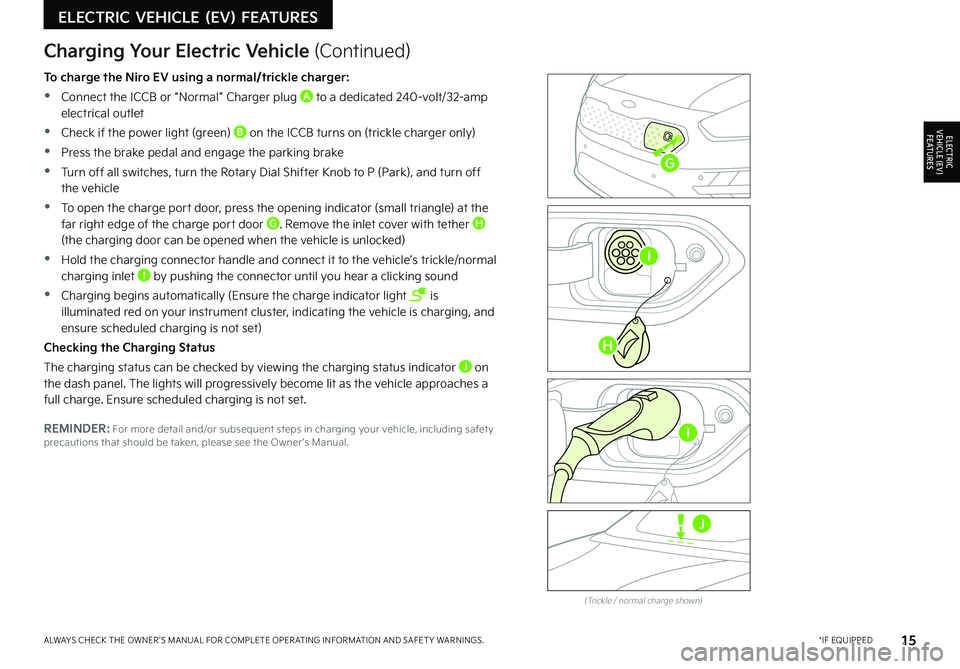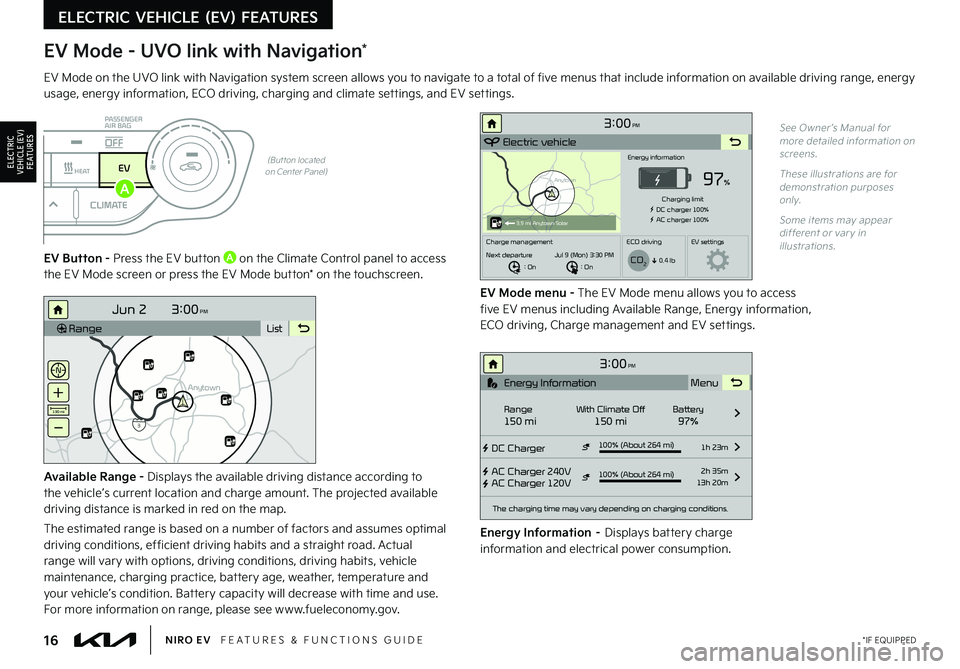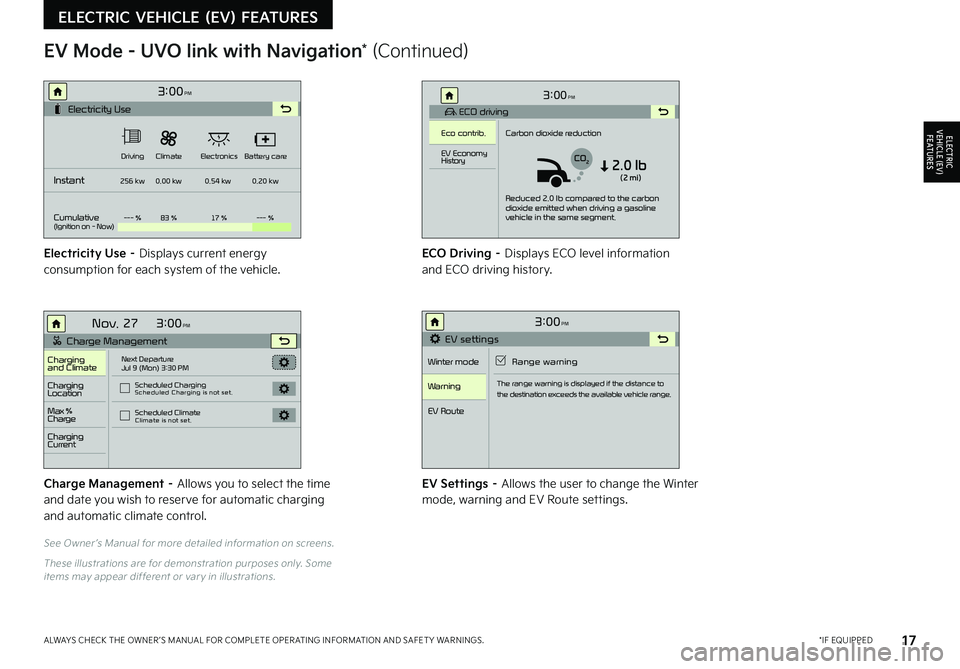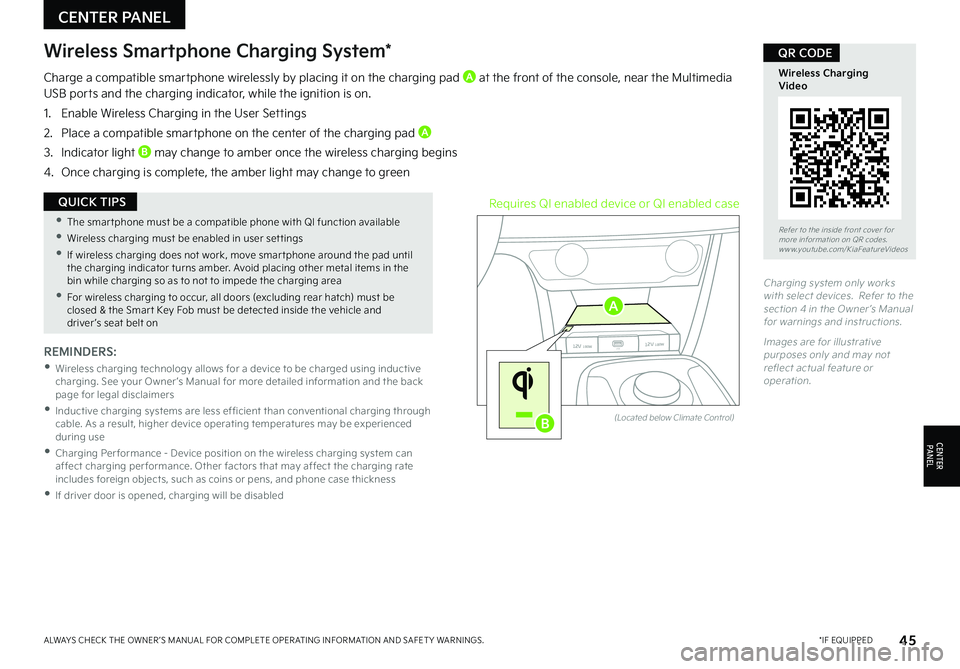2022 KIA NIRO EV charging
[x] Cancel search: chargingPage 16 of 62

14*IF EQUIPPEDNIRO EV FEATURES & FUNCTIONS GUIDE
Refer to the inside front cover for more information on QR codes .www .youtube .com/KiaFeatureVideos
Niro EV Charging – Connecting & Disconnecting Video
QR CODE
Level 1 Charging – “Trickle” Charge
A Level 1 or “trickle” charger is the most common type of charging system for an electric vehicle . This type of charger uses 120 volts/12 amps of household electricity and takes approximately 60 hours for a full charge .
Trickle Charger Indicators:
A 120VAC plug
B Power – Indicates that the charger and AC plug is plugged in and functioning
C Charge – Indicates that the vehicle is charging
D Fault – Indicates charge failure
E Charge Level – Indicates the level of charge – L (8A), M (10A), or H (12 A)
F ICCB – In-Cable Control Box
REMINDER: Do not use an extension cord . Plug trickle charger directly into wall socket . Do not charge to a receptacle that is not a dedicated circuit, old, damaged, corroded or cracked . When using outdoors, be careful not to expose it to external environments such as rain, snow, and high temperatures .
Level 2 Charging – “Normal” Charge (AC)
A Level 2 or “normal” 240-volt/32-amp charger is the recommended charging system for your electric vehicle . This type of charger uses 240 volts of electricity and takes approximately 9 .6 hours for a full charge . This charger may be able to be installed at your home by a qualified electrician or can be found at a public charging station .
REMINDER: Shape of charger and how to use the charger may be different for each manufacturer . Please see Owner ’s Manual for more information .
Level 3 Charging* – “Quick” Charge (DC)
A Level 3 or “quick ” DC charger is usually found at public charging stations . This type of DC charge may charge an electric vehicle in as little as 60 minutes to about an 80% charge .
REMINDER: Kia does not recommend primarily charging with a DC Charger because it can reduce the lifespan of the bat ter y .
Charging Your Electric Vehicle
REMINDER: For more detail and/or subsequent steps in charging your vehicle, including safet y precautions that should be taken, please see the Owner ’s Manual .
For more information on Level 3 Charging, refer to the Owner ’s Manual .
POWER
CHARGE
FA U LT
!
A
B
C
D
E
F
ELECTRIC VEHICLE (EV) FEATURES
ELECTRIC VEHICLE (EV) F E AT U R E S
A Level 2 or “normal” 240-volt/32-amp charger is recommended for regular charging of the vehicle .
QUICK TIP
LEVELLMH
Page 17 of 62

15*IF EQUIPPEDALWAYS CHECK THE OWNER ’S MANUAL FOR COMPLETE OPER ATING INFORMATION AND SAFET Y WARNINGS .
ELECTRIC VEHICLE (EV) FEATURES
ELECTRIC VEHICLE (EV) F E AT U R E S
Zero Emission
POWER
CHARGE
FAULT
(Trickle / normal charge shown)
Charging Your Electric Vehicle (Continued)
To charge the Niro EV using a normal/trickle charger:
•Connect the ICCB or “Normal” Charger plug A to a dedicated 240-volt/32-amp electrical outlet
•Check if the power light (green) B on the ICCB turns on (trickle charger only)
•Press the brake pedal and engage the parking brake
•Turn off all switches, turn the Rotary Dial Shifter Knob to P (Park), and turn off the vehicle
•To open the charge port door, press the opening indicator (small triangle) at the far right edge of the charge port door G . Remove the inlet cover with tether H (the charging door can be opened when the vehicle is unlocked)
•Hold the charging connector handle and connect it to the vehicle’s trickle/normal charging inlet I by pushing the connector until you hear a clicking sound
•Charging begins automatically (Ensure the charge indicator light is illuminated red on your instrument cluster, indicating the vehicle is charging, and ensure scheduled charging is not set)
Checking the Charging Status
The charging status can be checked by viewing the charging status indicator J on the dash panel . The lights will progressively become lit as the vehicle approaches a full charge . Ensure scheduled charging is not set .
REMINDER: For more detail and/or subsequent steps in charging your vehicle, including safet y precautions that should be taken, please see the Owner ’s Manual .I
J
G
H
I
Page 18 of 62

16 *IF EQUIPPEDNIRO EV FEATURES & FUNCTIONS GUIDE
EV Mode - UVO link with Navigation*
EV Mode on the UVO link with Navigation system screen allows you to navigate to a total of five menus that include information on available driving range, energy usage, energy information, ECO driving, charging and climate settings, and EV settings .
(But ton located on Center Panel)
EV Button - Press the EV button A on the Climate Control panel to access the EV Mode screen or press the EV Mode button* on the touchscreen .
EV Mode menu - The EV Mode menu allows you to access five EV menus including Available Range, Energy information, ECO driving, Charge management and EV settings .
Available Range - Displays the available driving distance according to the vehicle’s current location and charge amount . The projected available driving distance is marked in red on the map .
The estimated range is based on a number of factors and assumes optimal driving conditions, efficient driving habits and a straight road . Actual range will vary with options, driving conditions, driving habits, vehicle maintenance, charging practice, battery age, weather, temperature and your vehicle’s condition . Battery capacity will decrease with time and use . For more information on range, please see www .fueleconomy .gov .
Energy Information – Displays battery charge information and electrical power consumption .
See Owner ’s Manual for more detailed information on screens .
These illustrations are for demonstration purposes only .
Some items may appear different or var y in illustrations .
3:00PM
Range List
Anytown
3
Jun 2
+
–
130 mi
Anytown
3:00PM
Electric vehicle
97%
Energy information
Charging limit
DC charger 100% AC charger 100%
Charge management ECO drivingEV settings
Next departure : On : On
Jul 9 (Mon) 3:30 PM
0.4 lb
3.9 mi Anytown Solar
CO2
3:00PM
DC Charger
AC Charger 240V
AC Charger 120V100% (About 264 mi) 1h 23m
2h 35m
13h 20m
The charging time may vary depending on charging conditions.
Range150 miWith Climate Off150 miBattery97% Menu
Energy Information
100% (About 264 mi)
i
DRIVERAUTOACHEAT
CLIMATEOFF
ONLYEV
PASSENGER
AIR BAG
OFF
ELECTRIC VEHICLE (EV) FEATURES
ELECTRIC VEHICLE (EV) F E AT U R E S
A
Page 19 of 62

17 *IF EQUIPPEDALWAYS CHECK THE OWNER ’S MANUAL FOR COMPLETE OPER ATING INFORMATION AND SAFET Y WARNINGS .
See Owner ’s Manual for more detailed information on screens .
These illustrations are for demonstration purposes only . Some items may appear different or var y in illustrations .
EV Mode - UVO link with Navigation* (Continued)
Electricity Use – Displays current energy consumption for each system of the vehicle .ECO Driving – Displays ECO level information and ECO driving history .
Charge Management – Allows you to select the time and date you wish to reserve for automatic charging and automatic climate control .
EV Settings – Allows the user to change the Winter mode, warning and EV Route settings .
3:00PM
Instant
Cumulative(Ignition on - Now)Driving
256 kw
--- % 83 % 17 %--- %
0.00 kw
0.54 kw0.20 kw
Climate
ElectronicsBattery care
Electricity Use
3:00
Nov. 27PM
Charge Management
Charging
and ClimateNext Departure
Jul 9 (Mon) 3:30 PM
Scheduled Charging
Scheduled Charging is not set.
Scheduled ClimateClimate is not set.
Charging
Location
Charging
Current
Max %
Charge
3:00PM
EV settings
Winter mode Range warning
Warning
EV Route
The range warning is displayed if the distance to
the destination exceeds the available vehicle range.
3:00PM
ECO driving
Eco contrib. Carbon dioxide reduction
Reduced 2.0 lb compared to the carbon
dioxide emitted when driving a gasoline
vehicle in the same segment.
EV Economy
History
CO22.0 lb(2 mi)
ELECTRIC VEHICLE (EV) FEATURES
ELECTRIC VEHICLE (EV) F E AT U R E S
Page 47 of 62

Refer to the inside front cover for more information on QR codes .www .youtube .com/KiaFeatureVideos
Wireless Charging Video
QR CODE
REMINDERS:
•
Wireless charging technology allows for a device to be charged using inductive charging . See your Owner ’s Manual for more detailed information and the back page for legal disclaimers
•
Inductive charging systems are less ef ficient than conventional charging through cable . As a result, higher device operating temperatures may be experienced during use
•
Charging Per formance - Device position on the wireless charging system can affect charging per formance . Other factors that may affect the charging rate includes foreign objects, such as coins or pens, and phone case thickness
•If driver door is opened, charging will be disabled
Wireless Smartphone Charging System*
Charge a compatible smartphone wirelessly by placing it on the charging pad A at the front of the console, near the Multimedia USB ports and the charging indicator, while the ignition is on .
1 . Enable Wireless Charging in the User Settings
2 . Place a compatible smartphone on the center of the charging pad A
3 . Indicator light B may change to amber once the wireless charging begins
4 . Once charging is complete, the amber light may change to green
(Located below Climate Control)
Requires QI enabled device or QI enabled case
USB
12V 180W
12V 180W
12V 180W12V 180WUSB
USB
12V 180W
12V 180W
12V 180W12V 180WUSB
Charging system only works with select devices . Refer to the section 4 in the Owner ’s Manual for warnings and instructions .
Images are for illustrative purposes only and may not reflect actual feature or operation .
CENTER PANEL
CENTERPA N EL
•
The smar tphone must be a compatible phone with QI function available
•Wireless charging must be enabled in user set tings
•
If wireless charging does not work, move smar tphone around the pad until the charging indicator turns amber . Avoid placing other metal items in the bin while charging so as to not to impede the charging area
•
For wireless charging to occur, all doors (excluding rear hatch) must be closed & the Smar t Key Fob must be detected inside the vehicle and driver ’s seat belt on
QUICK TIPS
45*IF EQUIPPEDALWAYS CHECK THE OWNER ’S MANUAL FOR COMPLETE OPER ATING INFORMATION AND SAFET Y WARNINGS .
A
B
Page 61 of 62

OFF
LO
HI
Climate Control System* – page 46
Demo Defrost and Defog Windshield
EV Mode Displays* on the audio head unit – page 16
Instrument Cluster / EV Displays – pages 03-05
Windshield/Rear Wipers & Washers – page 36 Windshield: Move lever Up/Down to change Wiper modes. Rotate lever to adjust Intermit tent Wipe Speed.
WindshieldMIST: Single wipeOFF: Wipe offINT: Intermit tent wipeLO: Slow wipeHI: Fast wipe
220200
20
20 12 0
1 40
40
10 0
60
80
180
40 160
60 140
80 120
100
E
Fmi
RANGE
68
°c
CRUISE 60
mi/h
EPSECO
MPHelectric
LV .3
R ND
L H
2518 mi
DRIVERPASSENGER PASSENGER
AIR BAG
OFF
AUTO
AC EV
HEATCLIMATE
OFF
ONLY
Type A shown
Anytown
3:00
PM
Electric vehicle
97
%
Energy information
Charging limit
DC charger 100% AC charger 100%
Charge management ECO drivingEV settings
Next departure : On : On
Jul 9 (Mon) 3:30 PM
0.4 lb
3.9 mi Anytown Solar
CO2
Pull to spray and wipe.
Type B shown
Owner ’s Name:
VIN:
Mileage:
Dealership Name:
Sales Consultant:
Date:
BEFORE DELIVERY Test and confirm “Good Battery” using a Kia battery tester and affix Results Label Verify all tire pressures are to spec (see driver ’s door label) LF
LR
RF
RR
Verify proper operation of Remote Keyless Entry and Smart Key lock/unlock Ensure floor mats are snapped into place (if applicable) Verify vehicle is clean (interior and exterior), in good condition and free of chips and scratches Ensure all key documents are in the vehicle (Owner ’s Manual, Warranty and Consumer Information booklet, Tire Warranty booklet and Features & Functions Guide and any Audio System User ’s Manual)KEY FEATURE WALKTHROUGH
NIRO EV
DELIVERY CHECKLIST
*IF EQUIPPED